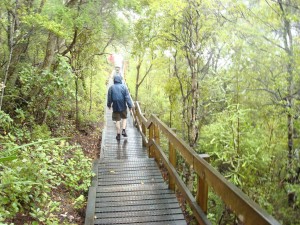(To view the youngest and largest extinct volcano)
It was my lifelong desire to see a volcano when I saw it in a movie during my school days. I was fully aware of the destructive nature of a volcano when it erupts and the hot lava that flows down burning everything that comes its way. But I was keen only to get a closer view of an extinct volcano and observe the vast changes it had brought to the areas surrounding it. When we planned a trip to New Zealand the first thing that struck my mind was to arrange a trip also to Rangitoto Island which has the youngest and biggest volcano in Auckland???s volcanic field.
As we alighted from the ferry and stepped into the island we felt as though we were entering a strange world completely different from the other habitations. The volcanic island 5.5 km wide that erupted from the sea with a series of explosions about 600 years ago is now defunct. It now appears at a distance as a distinctive symmetrical cone rising 260 meters above sea level.
We took a 25 minute ride in a ferry to the Rangitoto Island enjoying the scenic beauty around us and the stunning view of the coastline. As we advanced closer the rugged lava crops, lush native bush and the sandy coves of the island came into view. At the wharf where tourists disembark the only public transport available is the tractor drawn train that co-ordinates with the ferry service and takes tourists on a guided tour of the island.

The tractor drawn train took us through long stretches of lava fields, forests, exposed clinker like lava stones called scoria and arrived at the base of the summit on the eastern side of the volcano. While travelling we enjoyed the unfamiliar sights of the island???s interior and the coastal areas. A tour guide who accompanied us provided commentary about the history, geology and the flora and fauna of the island. After alighting from the tractor drawn train we walked along the boardwalk and arrived at the summit of the volcano. Tourists who are fit enough can walk from the wharf along the wooden summit tract and reach the summit. As it was raining we were provided with thick transparent raincoats covering the whole body. From the summit we had breathtaking views of the mainland and the Hauraki Gulf.
At the summit there is another tract that took us encircling the rim of the crater to have a closer view of it. After enjoying the 360-degree view from the summit we descended along the western side of the volcano and reached the ferry.
A short diversion on the walk up to the summit takes tourists on foot through lava tunnels and caves that were formed by the flow of the hot lava liquid during the volcano???s eruptions. Tourists are instructed to carry a torch light when they walk through the lava tunnels and caves. They are also instructed to wear sturdy clean footwear when they walk through the island???s rugged lava surfaces. After visiting the lava tunnels and the caves tourists can return to the summit tract along the sign posted tract. As we went unprepared for a walk through the lava tunnels and caves we continued our walk along the boardwalk and reached the summit.
There are no streams in the island as such plants have to rely mainly on rainfall thereby creating an unfavourable environment for plants to survive on the lava rocks. Yet more than 200 species of native trees and flowering plants thrive on the island which includes several species of orchids and more than 40 species of ferns. Besides these plants mosses and lichens also grow on the bare lava rocks.
Rangitoto being a pest free island providing sanctuary for wildlife, tourists are advised to check their bags before setting off on the journey to find out whether any rats, mice or other insect pests have stayed unnoticed in their bags. They should also ensure that weeds do not cling on to their clothing and shoes.
Tourists are also advised to take water and food in pest proof containers as there are no shops to purchase them in the island. They should also take with them hats and sunscreen to protect the skin from the damaging ultraviolet rays. In the absence of facilities to remove garbage in Rangitoto Island tourists have to take them when they leave the island.
Under the control of the Department of Conservation camping in the island is allowed by obtaining permit that too for camping during day time only. Overnight stay is not permitted as the entire island will be plunged in darkness after sunset, in the absence of power supply. And most importantly tourists must ensure that they do not miss the ferry back to the mainland otherwise travelling by private transport is very expensive.
Though Rangitoto Island without any population appears deserted, stepping into its wilderness to view the extinct volcano at close range and the tremendous changes it had brought about is a worthwhile lifetime experience.














